

This time, the Cabrillo crew journeyed to Mt. Lassen Volcanic National Park. Our goal was to study deep sky wonders under inky black skies far from light polluted cities, to study the crustal processes of the inner planets, including views of the celebrated Mars apparition of '03, and compare to the striking geologic history of Mt. Lassen National Park.
We had an outstanding group of students - eager, attentive, in good cheer,
ready to dig in and learn. We arrived Friday afternoon and evening, after Dave
McKulle went the extra mile and secured for us the group campsite on Thursday
next to beautiful Hat Creek. With 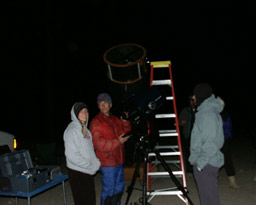 some
help, I worked up a delicious dinner of angel hair pasta and tomoto/basil sauce,
then on to the telescopes. JP brought his monster 25" Dobsonian, and I
brought the computerized 10" LX200. McKulle brought his 8" Dob, and
Bob brought his 8" Celestron. A nice suprise was Dave Bloomsness - long
time Cabrillo Astronomy Club member who's lived in Oregon for the past many
years, and who came down to join us. In the mid-90's Dave made a home for the
department's 14" fork mount scope after it was damaged by vandals. On this
trip, he brought a Dob mount built around the mirror - a neat and impressive
bit of engineering. I lectured around the scopes as we studied globular clusters,
open star clusters along the plane of the Milky Way, and used the laser to outline
the stellar disk and the inner dust layer which circled the sky along the galactic
plane.
some
help, I worked up a delicious dinner of angel hair pasta and tomoto/basil sauce,
then on to the telescopes. JP brought his monster 25" Dobsonian, and I
brought the computerized 10" LX200. McKulle brought his 8" Dob, and
Bob brought his 8" Celestron. A nice suprise was Dave Bloomsness - long
time Cabrillo Astronomy Club member who's lived in Oregon for the past many
years, and who came down to join us. In the mid-90's Dave made a home for the
department's 14" fork mount scope after it was damaged by vandals. On this
trip, he brought a Dob mount built around the mirror - a neat and impressive
bit of engineering. I lectured around the scopes as we studied globular clusters,
open star clusters along the plane of the Milky Way, and used the laser to outline
the stellar disk and the inner dust layer which circled the sky along the galactic
plane.
Above, Rebecca enjoys her first view of a globular cluster - ancient groupings
of a million stars we think were created by the collisions of the proto-galaxies
which formed our own Milky Way Galaxy 13 billion years ago.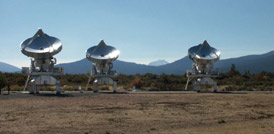
A highlight of the trip was a tour on Saturday morning of the Hat Creek Radio Observatory. This is the University of California's main radio observatory. Mt. Lassen pokes above the far range in the background.
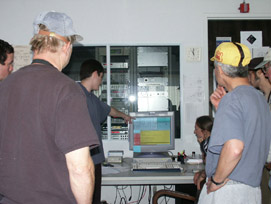 Josh
Simon is a PhD student at Berkeley who is studying dark matter. On this observing
run, he's measuring the rotation speed of carbon monoxide gas in the dwarf spiral
galaxy NGC 2976 in the M81 Group. At right he shows us the computers which control
the motion of the radio dishes.
Josh
Simon is a PhD student at Berkeley who is studying dark matter. On this observing
run, he's measuring the rotation speed of carbon monoxide gas in the dwarf spiral
galaxy NGC 2976 in the M81 Group. At right he shows us the computers which control
the motion of the radio dishes.
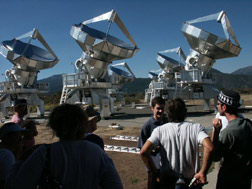 The
radio dishes are designed to operate in the millimeter wavelength range, permitting
the resolution of radio sources down to a few arcseconds. To improve resolution
further, the array is operated as an interferometer - linking the dishes in
phase to their resolution is equivalent to that of a dish roughly the diameter
of the entire array.
The
radio dishes are designed to operate in the millimeter wavelength range, permitting
the resolution of radio sources down to a few arcseconds. To improve resolution
further, the array is operated as an interferometer - linking the dishes in
phase to their resolution is equivalent to that of a dish roughly the diameter
of the entire array.
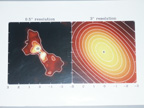 The
resulting improvement can be seen on these images of the intensity contours
of a radio galaxy.
The
resulting improvement can be seen on these images of the intensity contours
of a radio galaxy.
Later, I led the troops to the Mt. Lassen area. First stop was at visitor center, where I gave a lecture on the formation of the inner planets, and on how size and mass govern the cooling rate of planets and how we therefore explain the thin crusts of Earth and Venus and their resulting tectonic plate activity. I contrasted the "New York style" crust of the Earth with the "Chicago style" of the Moon, Mars, and Mercury - geologically dead planets because they cooled too quickly and have crusts too thick to permit present volcanism.
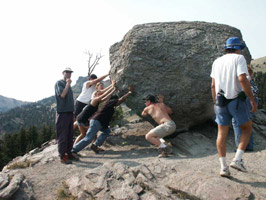 At
the trailhead to Bumpass Hell the gang does their Sisyphus imitation.
At
the trailhead to Bumpass Hell the gang does their Sisyphus imitation. 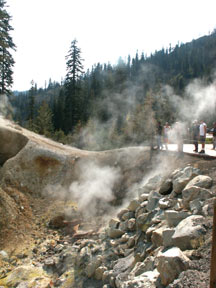
At the Sulphur Works we study boiling mud pots, the resulting deposits of elemental sulphur, and cyanobacteria growing in some of the pools.
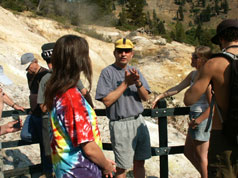 Mt.
Lassen last erupted less than 100 years ago and is still an active volcano.
At left, I explain it is the southern-most major volcano in the Cascade Range,
caused by the subduction of the last of the Juan de Fuca plate underneath the
North America tectonic plate.
Mt.
Lassen last erupted less than 100 years ago and is still an active volcano.
At left, I explain it is the southern-most major volcano in the Cascade Range,
caused by the subduction of the last of the Juan de Fuca plate underneath the
North America tectonic plate.
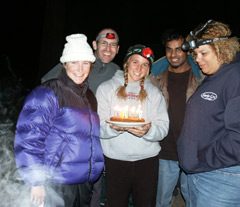 Back
at camp, I fixed another tasty dinner which we enjoyed around the campfire along
with my lecture on galaxies and cosmology. But the highlight... we celebrated
Rebecca's birthday with chocolate cake - Happy 21st, Rebecca!
Back
at camp, I fixed another tasty dinner which we enjoyed around the campfire along
with my lecture on galaxies and cosmology. But the highlight... we celebrated
Rebecca's birthday with chocolate cake - Happy 21st, Rebecca!
Then, to the scopes and more astronomy until after midnight. Sunday morning
- another crepes breakfast, some solar viewing with the 8" and filter.
The sun had been unusually 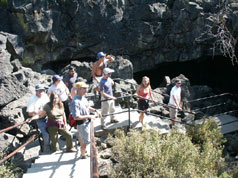 active
considering we were supposed to be coming back down from a strong solar maximum
2 years earlier.
active
considering we were supposed to be coming back down from a strong solar maximum
2 years earlier.
Also on the schedule was a trip 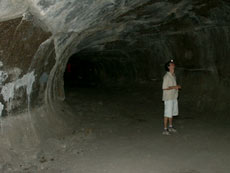 down
the road to subway cave. This is the best example of a lava tube in the country,
and one of the largest. It's nearly a quarter mile long, and requires a good
flashlight for all who enter - it's black down there. Lava tubes form when molten
lava forms a crust which insulates it from air cooling, allowing the flowing
lava to leave and empty the tube before solidifying.
down
the road to subway cave. This is the best example of a lava tube in the country,
and one of the largest. It's nearly a quarter mile long, and requires a good
flashlight for all who enter - it's black down there. Lava tubes form when molten
lava forms a crust which insulates it from air cooling, allowing the flowing
lava to leave and empty the tube before solidifying.